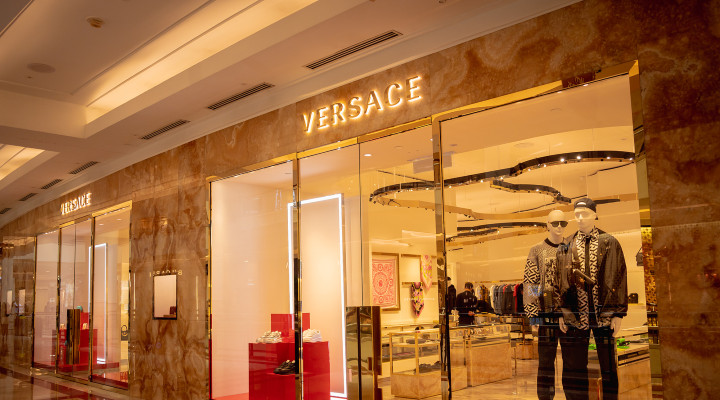The world of luxury retail is in for a shake-up, following last week’s announcement that Tapestry, the parent company of Coach, Kate Spade and Stuart Weitzmann, will acquire Capri Holdings, the owner of Versace, Jimmy Choo and Michael Kors, for US$8.5 billion. The move, which is expected to close in calendar year 2024, will create a global fashion empire with a presence in over 75 countries and combined sales in excess of $12 billion. But while the strategic acquisition makes
makes a lot of sense on paper – expanding Tapestry’s portfolio in the over $200 billion global luxury apparel, handbags, accessories and footwear market, and delivering an anticipated $200 million in run-rate cost synergies – industry experts question remain cautious.
“As the ink dries on the acquisition agreement by Tapestry, champagne corks will no doubt be flying at Capri’s HQ. However, if anyone needs to sober up, they only need to look at the latest trading numbers from the luxury group,” Neil Saunders, managing director of GlobalData, told Inside Retail.
They show a continued decline in Capri’s overall revenue, by 9.6 per cent, and a sharp deterioration on the bottom line where net income is down by 76.1 per cent.
“To be fair to Capri, there is a slowdown in the luxury space which is dampening the growth of all players, so a little softness in the numbers is to be expected. However, there are two factors that make Capri stand out,” he added.
First, Saunders said its numbers are worse than its rivals, which suggests the business is impacted by more than just the economy.
Second, Capri is performing badly off the back of a lacklustre period of trading, compared to rivals which are slowing down after a long stretch of elevated demand.
To put this in context, compared to the pre-pandemic period of 2019, Capri’s first quarter revenue is down by 8.7 per cent. Sales at Michael Kors are down by 19.8 per cent, and net income has risen by a very modest 6.7 per cent.
“Given that the market has boomed over this period and that Capri has bedded in some new brands, this is little short of an abysmal performance which marks the company out as one of the weakest players in the luxury space,” he noted.
Inflated valuations
According to Saunders, against this performance, the price that Tapestry paid for Capri seems extremely “toppy”.
“The recent trajectory of Capri, and especially the core Michael Kors brand, also means that Tapestry is not buying a business that is firing on all cylinders; it is buying a business that, while still perfectly roadworthy, needs a lot of maintenance and fine tuning,” he explained.
While Tapestry may very well be confident it has the skills needed to do the job, the size and scale of the work required, and the time it will take, should not be underestimated.
Looking in more detail at Capri’s Q1 results, which it reported last week following the acquisition announcement, it’s clear that the main issues stem from Michael Kors.
Sales at the brand slumped by a dismal 13.8 per cent, primarily due to a retrenchment by the consumer. However, Saunders said two things are particularly unfavourable for Michael Kors.
“First, it is exposed to channels like department stores where the economic softness is playing out. Second, it is, for the most part, a rather uncompelling brand that shoppers are willing to sacrifice when times get tough,” he elaborated.
Tricky times ahead
Saunders believes both dynamics make the brand much more susceptible to a slowdown than others in the luxury space.
“Given that Capri has only partially addressed these fundamental issues, the responsibility for reviving the flagging label will now fall squarely on Tapestry’s shoulders,” he opined.
Versace’s numbers were also down, though not to the same degree as Michael Kors, and they are more aligned with the slowdown that is being seen across the luxury space – especially in North America, where the brand saw all of its deterioration.
Jimmy Choo is the only brand in growth, largely thanks to some strong results in the EMEA region, and continued traction from its push into accessories.
“Unfortunately, the worst performing and most problematic part of Capri – Michael Kors – is also the biggest. And it will no doubt cause the biggest headache to Tapestry once the groups merge,” he said.
The next LVMH?
According to Javier Gonzalez Lastra, portfolio manager at Tema Luxury ETF, the rationale for Tapestry to acquire Capri makes a lot of sense.
“Mono-brand operations are risky because fashion can be fickle and can go as fast as it comes. Diversity, both by brand and also geography can bring a natural hedge that helps to substantially reduce volatility in running the business,” he told Inside Retail.
In addition, he said the combination brings synergies in many forms, including cost synergies in procurement, from the duplication of corporate costs, logistics, distribution and technology.
He thinks the combined group will still have a big skew towards affordable luxury, but some of the brands that Capri brings to the mix, Versace and Jimmy Choo, are higher-end and compete directly with the more premium-positioned European brands.
“It will be interesting to see what route Tapestry/Capri takes from here. Do they become bigger and bigger in affordable luxury or on the contrary try to elevate to the high end?,” he opined.
Ultimately, according to Saunders, even as a larger entity, Tapestry will still lack some of the prestige of the European luxury houses, which have brands with more panache, and which exude an easy self-confidence.
“Over time, Tapestry may remedy this by making more acquisitions. However, it won’t be in a position to do that until it has fully digested Capri,” he concluded.

